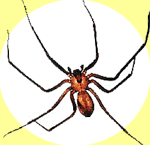
Frequently Asked Questions
Below are answers to the most frequently asked questions
we have received.
They are organized by category/subject.
Geography - Are Spiders in my neighborhood?
Spider Identification - I saw/caugt a spider,
what is it?
Bites-Identification, Symptoms, and Treatment
Spider Control - Natural preditors and commercial products
Email of bites from a Brown Recluse - Fact or Myth?
Find
a Local Dealer!
or
Buy
Online!
Have a question about spiders? Let SpiderExpert answer it!
Read Stories about Spider Bites and share your own.
Big H products also offers a large catalog of great products for Home
& Garden such as Fly
traps, Yellow
Jacket Traps, DiggitTM
tools, novelty
lighters, and more.
Click here to see our complete catalog of products.
Where do Hobo and Recluse Spiders live?
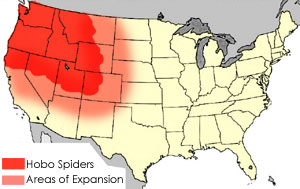 |
Hobo Spiders live in the Northern United States as well as Canada. They can be found anywhere in Washington, Oregon, Idaho, Montana, Wyoming, Utah, Colorado,and Southern British Columbia. We feel that it is likely that there are Hobos in Northern California. We have also received spider samples from the many parts of Mid-West and North Eastern USA which appear to be Hobo spiders. The Red areas of the maps show regions with Hobo Spiders.
|
 |
|
 |
Recluse Spiders live in the southern United States from California to Florida and up to Nebraska & Missouri and over to Virginia. |
Find
a Local Dealer!
or
Buy
Online!
Have a question about spiders? Let SpiderExpert answer it!
Read Stories about Spider Bites and share your own.
Big H products also offers a large catalog of great products for Home
& Garden such as Fly
traps, Yellow
Jacket Traps, DiggitTM
tools, novelty
lighters, and more.
Click here to see our complete catalog of products.
I saw/caught a Spider. How can I identify it?
First, visit the Identification Page to find a match. If you can't find your spider, send an email to info@hobospider.net and ask how to proceed. Let them know if you have digital pictures, live samples, or other resources.
What do Hobo and Brown Recluse Spiders look like?
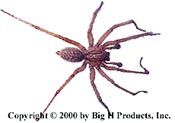 |
|
Male Hobo Spider |
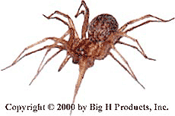 |
|
Female Hobo Spider |
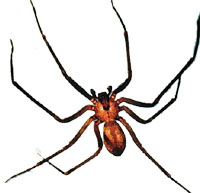 |
| Brown Recluse Spider |
Hobo Spiders are brown and measure roughly 12 to 18 mm in length. Their legs show no distinct rings and have short hairs. Their abdomens have several chevron shaped markings.
Males are distinctively different from females in that they have two large palps that look like boxing gloves. These palps are often mistaken for fangs or venom sacs, but they are in fact the male genitalia.
The females also have these palps, but the ends are not 'swollen' as they are on the males. Females tend to have a larger abdomen when compared to males.
The most recognized feature of the Brown Recluse spider is violin pattern on the cephalothorax or, in other words, the location on the top side of the spider near the head. Thus they have been nicknamed the Fiddleback Spider. This characteristic is common in adult brown recluses, but some young brown recluse spiders do not have any contrasting pigmentation in the violin region.
Recluse spiders also have abdomens devoid of any coloration pattern. Their legs lack thickened spines but are covered with fine hairs.
Unlike most U.S. spiders, the Brown Recluse spider has six eyes arranged
in pairs called dyads. (Most U.S. spiders have eight eyes arranged in
two rows of four.) One dyad is anterior, or toward the front, and the
other two are lateral, or toward the sides of the cephalothorax (where
the first legs of the spider attach to the body). All 13 species of U.S.
recluses have this same eye pattern.
Return to the Top
Find
a Local Dealer!
or
Buy
Online!
Have a question about spiders? Let SpiderExpert answer it!
Read Stories about Spider Bites and share your own.
Big H products also offers a large catalog of great products for Home
& Garden such as Fly
traps, Yellow
Jacket Traps, DiggitTM
tools, novelty
lighters, and more.
Click here to see our complete catalog of products.
What does a Brown Recluse Spider Bite look like?
 To the
left is a picture of a Hobo Spider bite. Brown Recluse bites are the same.
About 50% of bites are 'dry,' meaning that no venom is injected, and nothing
happens to the victim. Often times the victim does not even realize that
he has been bit.
To the
left is a picture of a Hobo Spider bite. Brown Recluse bites are the same.
About 50% of bites are 'dry,' meaning that no venom is injected, and nothing
happens to the victim. Often times the victim does not even realize that
he has been bit.
What will happen after I'm bit?
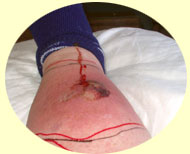 Typically,
when venom is injected, the victim will experience an immediate redness
which develops around the bite, then begins to disappear within a few
hours. Very often, for the first 24 hours, the bite appears to be no worse
than that of a mosquito; then it begins to blister in the center. Within
24 to 36 hours the blister breaks open leaving an open, oozing ulceration.
Typically,
when venom is injected, the victim will experience an immediate redness
which develops around the bite, then begins to disappear within a few
hours. Very often, for the first 24 hours, the bite appears to be no worse
than that of a mosquito; then it begins to blister in the center. Within
24 to 36 hours the blister breaks open leaving an open, oozing ulceration.
This ulceration 'scabs' over within three weeks from the initial bite, leaving a permanent scar. If the bite is delivered in fatty tissue, the lesion may be very deep and extensive and not heal for two or three years. Systematic reactions to Hobo Spider poisoning include severe headaches, nausea, vomiting, soreness, and flu-like symptoms.
What should I do if I get bit?
Consult a physician. In extreme cases where the bite was not taken care
of early, skin graft, amputation, and the possibility of bone marrow failure
may occur.
Return to the Top
Find
a Local Dealer!
or
Buy
Online!
Have a question about spiders? Let SpiderExpert answer it!
Read Stories about Spider Bites and share your own.
Big H products also offers a large catalog of great products for Home
& Garden such as Fly
traps, Yellow
Jacket Traps, DiggitTM
tools, novelty
lighters, and more.
Click here to see our complete catalog of products.
What are natural preditors of Hobo and Brown Recluse Spiders?
There are 3 major predator spider types that if found in homes seem to reduce the amount of Hobo spiders: the Steatoda spiders, Large jumping spiders, and the other harmless European House spiders.
Pets such as cats will feed on Hobo and Brown Recluse spiders after playing with them. The preying mantis will also eat Hobo spiders but due to its day time activity and the Hobo spiders night time activity optimum results are not achieved.
Other competitors or predators would include birds, cats, "cat face" spiders, wolf spiders, some crab spiders, several wasps, and other web weavers that may catch a hobo in its web and then feast. The reason for some of the effectiveness of these other insects is not because they are incredible hunters. Instead, it is because of competitive exclusion or in other words, there just isn't enough room or food for the hobo spider so it won't try to make a home.
How can I control Hobo and Brown Recluse Spiders?
The foremost expert on Hobo Spiders, stated that ". . . traps are far and away the most safe and effective measure that can be used for controlling hobo spiders indoors." And, in fact, traps have shown to be the most effective means available to control Hobo & Brown Recluse Spider populations.
In order to kill Hobo or Brown recluse spiders with pesticides you usually have to hit
the spider directly with large doses. The problem with non discriminate
spraying is that you kill the good competitor and predator spiders and
insects and thus make more room for the more mobile and hardy Hobo & Brown recluse spiders.
This will often lead to a worse problem as one man witnessed
in 1997 in his own home.
Return to the Top
Find
a Local Dealer!
or
Buy
Online!
Have a question about spiders? Let SpiderExpert answer it!
Read Stories about Spider Bites and share your own.
Big H products also offers a large catalog of great products for Home
& Garden such as Fly
traps, Yellow
Jacket Traps, DiggitTM
tools, novelty
lighters, and more.
Click here to see our complete catalog of products.
Email Photos of Spider Bites - Are they Real?
Many people have been circulating a series of images showing a terrible bite with the skin deteriorating to the bone claiming the injury to be a brown recluse spider bite. An expert offers the following:
It is possible that the wound did result from a recluse bite. However, a number of aspects of this story are pretty suspicious, and have the classic symptoms of a hoax.
No one can seem to verify where the alleged bite occurred, whether a spider was caught in the act of biting or at the scene of the crime, whether the victim was tested for additional etiologic agents of necrosis such as bacterial infection, if a doctor actually made the diagnosis or it was a self-diagnosis from the victim, if the diagnosis came from an area of the country that actually has brown recluses, etc.
Some versions of this have included a picture of a spider that was supposed THE spider that caused the wound. Not so. It is a stock photo from an Ohio university website. This image was used last year in a very hyperbolic news story in Long Island.
The final summary on this is that if it indeed is a brown recluse bite, then it is truly one of the rare, horrific ones however, there is not sufficient information provided with this image to ascertain whether it is credible or not.
Rick Vetter Entomology Univ. Calif. Riverside Riverside, CA 92521
Find
a Local Dealer!
or
Buy
Online!
Have a question about spiders? Let SpiderExpert answer it!
Read Stories about Spider Bites and share your own.
Other Resources
Have your questions answered:
SpiderExpert.com
Read Stories about Spider Bites and share your own.
Read what Dr. Kenneth Burton has to say.
Learn more about HoboSpiders:
HoboSpider.com
©2003 Big H Products, Inc.
designed by PlanetAdvertise.com